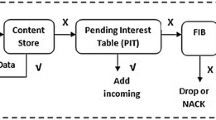Abstract
Internet users seek solutions for mobility, multi-homing, support for localised address management (i.e. via NATs), and end-to-end security. Existing mobility approaches are not well integrated into the rest of the Internet architecture, instead primarily being separate extensions that at present are not widely deployed. Because the current approaches to these issues were developed separately, such approaches often are not harmonious when used together. Meanwhile, the Internet has a number of namespaces, for example the IP address or the Domain Name. In recent years, some have postulated that the Internet’s namespaces are not sufficiently rich and that the current concept of an address is too limiting. One proposal, the concept of separating an address into an Identifier and a separate Locator, has been controversial in the Internet community for years. It has been considered within the IETF and IRTF several times, but always was rejected as unworkable. This paper takes the position that evolving the naming in the Internet by splitting the address into separate Identifier and Locator names can provide an elegant integrated solution to the key issues listed above, without changing the core routing architecture, while offering incremental deployability through backwards compatibility with IPv6.
Similar content being viewed by others
References
Aboba, B., & Dixon, W. J. (2004). IPsec-Network address translation (NAT) compatibility requirements. RFC 3715, IETF.
Arends, R., Austein, R., Larson, M., Massey, D., & Rose, S. (2005). DNS security introduction and requirements. RFC 4033, IETF.
Balakrishnan, H., Lakshminarayanan, K., Ratnasamy, S., Shenker, S., Stoica, I., & Walfish, M. (2004). A layered naming architecture for the Internet. ACM Computer Communications Review, 34(4), 343–352.
Cheriton, D., & Gritter, M. (2000). TRIAD: A new next generation Internet architecture. Technical report, Stanford University, Stanford, CA, USA.
Chiappa, N. (1994). IPng technical requirements of the nimrod routing and addressing architecture. RFC 1753, IETF.
Clark, D., Braden, R., Falk, A., & Pingali, V. (2003). FARA: Reorganizing the addressing architecture. ACM Computer Communications Review, 33(4), 313–321.
Cohen, D. (1978). On names, addresses, and routings. Internet experiment note (IEN) 23, ARPA Network Working Group.
Crowcroft, J., Hand, S., Mortier, R., Roscoe, T., & Warfield, A. (2003). Plutarch: An argument for network pluralism. In FDNA 2003: Proceedings of the ACM SIGCOMM workshop on future directions in network architecture (pp. 258–266). New York: ACM Press.
Eastlake, D., Schiller, J., & Crocker, S. (2005). Randomness requirements for security. RFC 4086, IETF.
Egevang, K., & Francis, P. (1994). The IP network address translator (NAT). RFC 1631, IETF.
Ferguson, P., & Senie, D. (1998). Network Ingress filtering: defeating denial of service attacks which employ IP source address spoofing. RFC 2267, IETF.
Francis, P., & Gummadi, R. (2001). IPNL: A NAT-extended Internet architecture. In Proceedings of ACM SIGCOMM 2001 (pp. 69–80). New York: ACM Press.
Holdrege, M., & Srisuresh, P. (2001). Protocol complications with the IP network address translator. RFC 3027, IETF.
Huttunen, A., Swander, B., Volpe, V., DiBurro, L., & Stenberg, M. (2005). UDP encapsulation of IPsec ESP packets. RFC 3948, IETF.
IEEE. (2007). Guidelines for 64-bit global identifier (EUI-64). Tutorial, IEEE.
Johnson, D. B., Perkins, C. E., & Arkko, J. (2004). Mobility support in IPv6. RFC 3775, IETF.
Jonsson, A., Folke, M., & Ahlgren, B. (2003). The split naming/forwarding network architecture. In Proceedings of 1st Swedish national computer networking workshop, Arlandastad, Sweden, September 2003.
Liu, C., & Albitz, P. (2006). DNS and BIND (5th ed.). Sebastopol: O’Reilly and Associates.
Macker, J. (2003). Interoperable networks for secure communications, task 6, phase 1. Final report INSC-TASK6, North Atlantic Treaty Organisation (NATO).
Meyer, D., Zhang, L., & Fall, K. (2007). Report from the IAB workshop on routing and addressing. RFC 4984, IAB.
Moore, N. (2006). Optimistic duplicate address detection for IPv6. RFC 4429, IETF.
Moskowitz, R., & Nikander, P. (2006). Host identity protocol architecture. RFC 4423, IETF.
O’Dell, M. (1996). 8+8—An alternate addressing architecture for IPv6. Internet-draft draft-odell-8+8-00.txt, IETF.
Perkins, C. E. (Ed.) (1996). IP mobility support. RFC 2002, IETF.
Saltzer, J. H. (1993). On the naming and binding of network destinations. RFC 1498, IETF.
Schmid, S., Eggert, L., Brunner, M., & Quittek, J. (2005). TurfNet: An architecture for dynamically composable networks. In Lecture Notes in Computer Science (Vol. 3457, pp. 94–114). Springer, Berlin
Shoch, J. (1978). Inter-network naming, addressing, and routing. Internet experiment note 19, ARPA Network Working Group.
Stoica, I., Adkins, D., Zhuang, S., Shenker, S., & Surana, S. (2002). Internet indirection infrastructure. ACM Computer Communications Review, 32(4), 73–86.
Turanyi, Z., Valko, A., & Campbell, A. T. (2003). 4+4: An architecture for evolving the Internet address space back toward transparency. ACM Computer Communications Review, 33(5), 43–54.
Wellington, B. (2000). Secure domain name system (DNS) dynamic update. RFC 3007, IETF.
Weston, J. (2006). Interoperable networks for secure communications, task 3. Final report INSC-TASK3, North Atlantic Treaty Organisation (NATO).
Author information
Authors and Affiliations
Corresponding author
Rights and permissions
About this article
Cite this article
Atkinson, R., Bhatti, S. & Hailes, S. ILNP: mobility, multi-homing, localised addressing and security through naming. Telecommun Syst 42, 273 (2009). https://doi.org/10.1007/s11235-009-9186-5
Published:
DOI: https://doi.org/10.1007/s11235-009-9186-5




